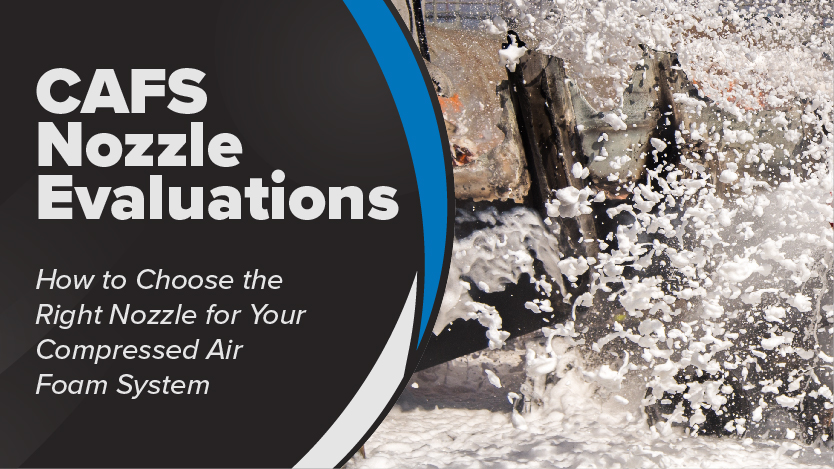Evaluating Nozzles for Compressed Air Foam Systems (CAFS)
When evaluating nozzles for use with CAFS, there are four criteria that affect firefighter safety and firefighting efficiency. These are target delivery rate, finished foam quality, stream reach, and nozzle reaction force. Before we discuss each of these, let's quickly discuss the use of Class A foam with a compressed air foam system.
Class A Foam and CAFS
First things first; when delivering Class A foam through CAFS, make no mistake, the water in the compressed air foam stream provides the cooling effect to extinguish fire. Nothing takes the place of water – this means that while compressed air and foam concentrate are required in the right volumes to make the end-result (compressed air foam), both are secondary to an appropriate water delivery rate. That is why understanding your target delivery rate is so important.
Target Delivery Rate
The first consideration when you are evaluating any nozzle for use with CAFS is establishing target delivery rate. Regarding CAFS hardware, delivery rates are expressed in gallon per minute (gpm) of foam solution and cubic feet per minute (cfm) of compressed air, or gpm/cfm.
You will need to choose target delivery rates (gpm and cfm) for each different size diameter attack hose line on the apparatus. Target delivery rates for foam solution — gpm delivery rate of liquid — should be kept close to, or at, those flow rates previously used with legacy water application.
For example, in a perfect world, if you were using 120 gpm of water for initial fire attack from a 1-3/4-inch hose line, consider setting your CAFS pump to deliver 120-gpm of foam solution and 60-cfm of air through the same hoseline. This equates to a 1-gpm to ½-cfm ratio.
When selecting a nozzle for use with CAFS, make sure it can discharge target delivery rate and provide high-quality foam streams with manageable nozzle reaction force.
Target Delivery Rate and Nozzle Diameter
The nozzle diameters required for effective compressed air foam discharge are radically different compared to what is needed when applying water only. Talking about nozzle diameters for water and compressed air foam applications at the same time is like talking about apples and oranges. They are very different, and it is important that you do not confuse the two.
For example, delivering water only, a 1-3/4-inch hose line with a ¾-inch diameter smoothbore nozzle at 55-psi nozzle pressure will deliver 124-gpm.
Whereas the same 1-3/4-inch hose line will need a much larger diameter smooth bore for compressed air foam — delivering compressed air foam at a 120-gpm and 60-cfm delivery rate will require a 1-3/8-inch diameter smoothbore nozzle.
Why is such a larger size diameter tip needed, when using CAFS?
In basic terms, the nozzle opening is delivering more “media.” Not only must liquid (foam solution) be expelled through the nozzle opening, both liquid and compressed air must be expelled together, at the same time. The volume of media being expelled from the nozzle demands a larger opening. Thus, larger diameter nozzles are needed.
With CAFS, you will need much larger nozzle openings (apertures) than you have used for ordinary water-only applications.
 |
The Thunderfog selectable gallonage nozzle has five flow settings – 95-, 125-, 150-, 200-, and 250-gpm at 100 psi. It also has a “Flush” setting. The author has used this nozzle on the “flush” setting for compressed air foam application. Using it on “flush” provides the much larger nozzle opening/aperture that is required to deliver compressed air foam. During fire operations, should an immediate need to revert to water occur, a quick twist of the gallon adjustment setting can re-adjust to deliver 125- or 150-gpm. |
Foam Quality
Another consideration during a CAFS nozzle evaluation includes analyzing foam quality – the consistency of finished-foam produced.
Most CAFS produce a wide range of foam consistencies – from runny “wet” to shaving cream “dry.” This occurs by adjusting air and foam solution discharge ratios. The more air introduced into your hose line, the dryer your finished foam. The less air, the wetter your finished foam.
During your nozzle evaluation, examine foam quality produced by each type of nozzle. Some nozzles are too restrictive. Internal waterways can destroy the compressed air foam bubble structure as the finished-foam media passes through restrictions inside the device. Evaluate dry compressed air foam through both fog and smoothbore nozzles to see foam quality differences. Identify which nozzle creates the best quality finished foam through “wet” to “dry” foam adjustment range.
Since CAFS pumps deliver high-quality compressed air foam to the nozzle, the less disruption that occurs as media passes through the nozzle device itself, the better the foam application. That’s why an appropriate diameter smooth bore nozzle has real foam application benefits.
Smoothbore nozzles also have drawbacks, though. Specifically, problems occur when pump operators fail to operate the CAFS pump correctly, or if a fog pattern is needed during fire attack.
Stream Reach
You should consider stream reach when selecting a CAFS nozzle since it affects stand-off distance from a fire hazard.
Reaction Force
Target flow rates discharged through specific nozzles will have an associated nozzle reaction force. Nozzle reaction force must be kept manageable for your nozzle operator and hose team. Nozzle reaction force is a function of target flow rate and the size and design of a nozzle orifice. Hose teams must be trained to safely handle reaction force throughout the nozzle flow range.
Summary
It cannot be overemphasized that fire crews need adequate hands-on training and classroom education on nozzle objectives, advantages, limitations, and drawbacks. Each fire district should decide which type of nozzle(s) work best for their purposes under local firefighting conditions.
The above discussion is intended to provide a broad overview of some of the issues and items for consideration when performing a CAFS nozzle evaluation. This is not intended to be all inclusive and doesn’t cover all topics regarding nozzles and nozzle evaluations using CAFS.
